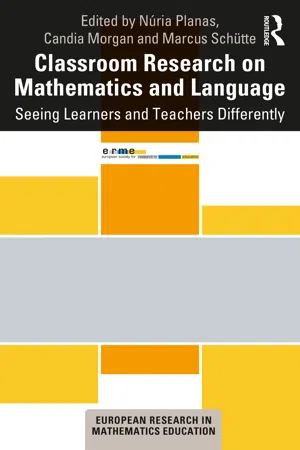Introduction
In this volume, we find chapters that review research over several decades and chapters that provide us with insight into current theoretical and empirical research on language and mathematics in classrooms. This chapter has been written after reading and learning from the work represented in all these other chapters. Our intention is to reflect and build on this work, and on some common challenges, in order to look forward into the next decade:
What are the major issues that future research on language and mathematics in classrooms needs to address?
What theoretical perspectives seem to be particularly useful to advance the research field?
What kinds of empirical research and methodological approaches should we consider for future research in the field?
These questions about present knowledge and future directions for progress have not always received answers throughout the history of classroom research on mathematics and language. Today, these questions are as important and pertinent as they were decades ago. Nonetheless, now perhaps more than ever, we must take into account that answers to them cannot be derived solely from the current ‘state of the art’ in mathematics education but must also be informed by boundary work around developments in related disciplines, as well as by an understanding of how the world itself is changing and how this may affect classrooms, the people who inhabit them and the ways in which they communicate.
The world we are living in appears increasingly fluid in its linguistic and cultural composition. According to the United Nations,1 the number of international migrants (living in a country other than the one in which they were born) has risen by nearly a quarter in the decade from 2010 to 2019, now comprising 3.5% of the global population, compared to 2.8% in 2000 and 2.3% in 1980. If these numbers still seem comparatively small, one has to bring to mind their consequences by looking more closely. In recent years, a rapidly growing linguistic and cultural pluralisation of society can be seen in many countries around the world. For example, in Germany, the most populous country in Europe, around 19 million people (23.6% of the population) are said to have a migration background, according to the Federal Commissioners for Migration, Refugees and Integration.2 If one looks at children as the group of most interest for educational processes, this percentage increases notably, with approximately 34% of primary school children identified as having a migration background. Linguistic and cultural diversity has long been the norm in many German schools, especially in the metropolitan areas of large cities. Such statistics, however, are not neutral. They depend on the working definitions for migrant and migration background, which may differ across Germany, the UK, Spain, and other states. Such official statistics exist amidst discourses that emphasise state citizenship, place of birth, parentage and processes of ‘ethnic monitoring’ (in contexts of schooling and employment of the UK, for example, people are asked to self-declare which of a list of ‘ethnic groups’ they identify with). More generally, they are statistics that do not capture the range of expressions of diversity in classrooms. That said, and regardless of the definitions for migrant and migrant background, linguistic and cultural diversity has become the norm in metropolitan regions of Europe and in many other regions of the world. Migration, due to economic need or ambition, conflict or natural disaster, adds to the linguistic and cultural diversity already existing in many communities – but is not the only source of change. New technologies and access to international communication, whether in the form of social media, video conferencing or television, bring people into contact with languages and cultures outside their local environment. Changes in the global economy are beginning to challenge the privileging of English and anglophone cultures in many areas of activity as, for example, China and other Far Eastern countries claim a larger stake and higher status in international affairs. All these developments erode linguistic isolation, provide wider access to a broad range of linguistic and cultural resources and require us to think in new ways about multilingualism and multiculturalism in education.
We noted in Planas, Morgan and Schütte (2018) that recent developments in research into language and mathematics education have been characterised by increasing complexity in the ways researchers have conceptualised language. As we look forward, we are challenged not only by the need to address theoretical complexity in the field but also by the need to address a recurring theme of increasing multiplicity. In line with these two major issues and in response to our first question, we suggest that our work needs to address the recognition of complexity in combination with an acknowledgement and understanding of multiplicity, focussing on three nodes: multilingualism and multiculturalism, multimodality, and multiple levels of analysis. Such a three-fold frame articulates our discussion, on the one hand, of theoretical perspectives that seem particularly useful to advance the research field and, on the other hand, of kinds of empirical research and methodological approaches for future classroom research on mathematics and language. In ...
